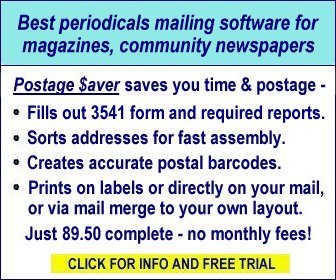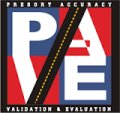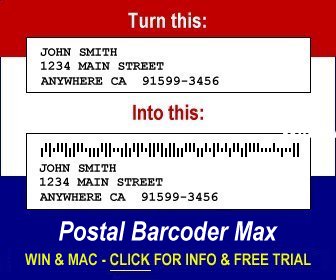Learn About Bulk Mailing and Tracking → Periodicals
 Scott
Scott
Postage $aver Software
USPS Periodicals class is a special postal category that offers low rates for newspapers, magazines and other regularly-scheduled publications, such as college course catalogs, bus schedules, and legal reporting services. In the past, Periodicals class was called Second Class Mail.
 There are detailed eligibility requirements to use Periodicals class, but the most important are that the publication be "issued at a regular frequency of at least four times a year" and mailed primarily to those who have subscribed to or requested the publication.
There are detailed eligibility requirements to use Periodicals class, but the most important are that the publication be "issued at a regular frequency of at least four times a year" and mailed primarily to those who have subscribed to or requested the publication.
So, if you're mailing your newspaper to everyone in an area whether they asked for it or not, you cannot use Periodicals class. In that case, Every Door Direct Mail (EDDM) might the best choice.
Similarly, if your publication is a one-time mailing, or is not published on a regular schedule, then EDDM or Marketing Mail might be cheapest if the pieces weigh less than a pound, or Bound Printed Matter might be cheapest if they are heavier.
Here's what this page covers:
 What are the rates?
What are the rates?
 How many pieces do I need?
How many pieces do I need?
 What are the size and weight limits?
What are the size and weight limits?
 How much are permits?
How much are permits?
 How do I apply for nonprofit rates?
How do I apply for nonprofit rates?
 What else do I need to get started?
What else do I need to get started?
Periodicals class mailers must keep accurate records for each issue published, including the number of copies printed, how the copies were distributed, and lists of subscribers and requesters.
Periodicals class can be used only for domestic mail (including military addresses, Puerto Rico and U.S. territories and possessions). If you need to send large quantities of international mail, check out this guide.
How to Save Postage with USPS Periodicals Class Mail
 Scott
ScottPostage $aver Software
USPS Periodicals class is a special postal category that offers low rates for newspapers, magazines and other regularly-scheduled publications, such as college course catalogs, bus schedules, and legal reporting services. In the past, Periodicals class was called Second Class Mail.
 There are detailed eligibility requirements to use Periodicals class, but the most important are that the publication be "issued at a regular frequency of at least four times a year" and mailed primarily to those who have subscribed to or requested the publication.
There are detailed eligibility requirements to use Periodicals class, but the most important are that the publication be "issued at a regular frequency of at least four times a year" and mailed primarily to those who have subscribed to or requested the publication.So, if you're mailing your newspaper to everyone in an area whether they asked for it or not, you cannot use Periodicals class. In that case, Every Door Direct Mail (EDDM) might the best choice.
Similarly, if your publication is a one-time mailing, or is not published on a regular schedule, then EDDM or Marketing Mail might be cheapest if the pieces weigh less than a pound, or Bound Printed Matter might be cheapest if they are heavier.
Here's what this page covers:
Periodicals class mailers must keep accurate records for each issue published, including the number of copies printed, how the copies were distributed, and lists of subscribers and requesters.
Periodicals class can be used only for domestic mail (including military addresses, Puerto Rico and U.S. territories and possessions). If you need to send large quantities of international mail, check out this guide.
What are the postage rates for Periodicals class bulk mail?
Periodicals class postage is the most complicated of all USPS rates to calculate. The only way to really know what a particular mailing might cost is to run the circulation list through software like Postage $aver. But our postage calculator below will at least give you an idea of the pricing.
The postage rate for Periodicals class bulk mail depends on the size and weight of the mail piece, how much of the publication is advertising, and whether the recipient is in the same county as the sender. There are also discounts for taking your mailing to a major sorting facility. You may pay different postage rates on different pieces in the same mailing, depending on where the pieces are going.
Nonprofits get small additional discounts off of the commercial Periodicals class rates, and there are also discounts for publications for classroom use and for certain publications related to agriculture.
After calculating the postage for each piece, there are additional charges for each "bundle" of mail, and for each tray. For mailings that are large enough to require pallets, there is a charge for each pallet.
Use our Periodicals class postage rate calculator to find the rates available for your mailing:
Rates updated for latest USPS changes effective Jan. 21, 2024.
Make the following selections to find the rates available for your Periodicals class mailing.
Publication is:
Commercial Nonprofit
Classroom Science of agriculture
Percentage of the publication that is advertising (0-100):
Select mail size:
Letter - up to 6⅛" x 11½" x ¼", whether in an envelope or not.
Flat - up to 12" x 15" x 1¼", whether in an envelope or not.
For flats, is the publication mailed in a box, or otherwise not flexible, or more than ¾" thick?
yes no
Weight in ounces - must be 70.4 ounces (4.4 pounds) or less:
How many total pieces are there in the mailing?
Fewer than 10,000
10,000 or more
How many pieces go to addresses within the county where the publisher's office is located?
Half, or fewer than half, of the entire mailing
More than half of the entire mailing
How many pieces go to addresses outside of the county where the publisher's office is located?
Fewer than 5000
5000 or more
See, I told you these rates are complicated.
If you already have the list you want to mail to, we recommend you download a free trial copy of our Postage Saver bulk mail software, and run your list through it. It will figure out the exact postage you'd pay for mailing that specific list, and let you try various options.
The postage rate for Periodicals class bulk mail depends on the size and weight of the mail piece, how much of the publication is advertising, and whether the recipient is in the same county as the sender. There are also discounts for taking your mailing to a major sorting facility. You may pay different postage rates on different pieces in the same mailing, depending on where the pieces are going.
Nonprofits get small additional discounts off of the commercial Periodicals class rates, and there are also discounts for publications for classroom use and for certain publications related to agriculture.
After calculating the postage for each piece, there are additional charges for each "bundle" of mail, and for each tray. For mailings that are large enough to require pallets, there is a charge for each pallet.
Use our Periodicals class postage rate calculator to find the rates available for your mailing:
Periodicals Class Bulk Mail Postage Rate Calculator
Rates updated for latest USPS changes effective Jan. 21, 2024.
Make the following selections to find the rates available for your Periodicals class mailing.
Publication is:
Commercial Nonprofit
Classroom Science of agriculture
Percentage of the publication that is advertising (0-100):
Select mail size:
Letter - up to 6⅛" x 11½" x ¼", whether in an envelope or not.
Flat - up to 12" x 15" x 1¼", whether in an envelope or not.
For flats, is the publication mailed in a box, or otherwise not flexible, or more than ¾" thick?
yes no
Weight in ounces - must be 70.4 ounces (4.4 pounds) or less:
How many total pieces are there in the mailing?
Fewer than 10,000
10,000 or more
How many pieces go to addresses within the county where the publisher's office is located?
Half, or fewer than half, of the entire mailing
More than half of the entire mailing
How many pieces go to addresses outside of the county where the publisher's office is located?
Fewer than 5000
5000 or more
(Rates will appear here when you fill in the information above.)
See, I told you these rates are complicated.
If you already have the list you want to mail to, we recommend you download a free trial copy of our Postage Saver bulk mail software, and run your list through it. It will figure out the exact postage you'd pay for mailing that specific list, and let you try various options.
How many pieces do I need to get Periodicals class rates?
For Periodicals class, there is no minimum per mailing, nor are there any minimums per zip code, month or year, as long as your publication meets the eligibility requirements.
What are the size and weight limits for Periodicals class rates?
Mail pieces sent at Periodicals class rates must weigh no more than 70.4 ounces (4.4 pounds). To qualify for barcoding discounts, each piece can weigh no more than 20 ounces.
The longer side of each piece must be no more than 15 inches long. The shorter side must be no more than 12 inches long. Nonbarcoded pieces can be up to 1¼" thick. Barcoded pieces can be no more than 3/4" thick.
The longer side of each piece must be no more than 15 inches long. The shorter side must be no more than 12 inches long. Nonbarcoded pieces can be up to 1¼" thick. Barcoded pieces can be no more than 3/4" thick.
What are the permit fees for sending Periodicals class mail?
You must have authorization from USPS before you can use Periodicals class rates. The one-time fee for a Periodicals class authorization is $950. The fee is paid directly to USPS. A vendor cannot issue mailing authorization to you.
There is no separate Permit Imprint Authorization Fee required for Periodicals class. Periodicals class mail does not require any form of postage (indicia, stamps, or meter strip) to be printed on or attached to the piece.
How to apply for Periodicals class authorization: You must apply for your authorization in person, using USPS form 3500.
Where to apply: You must take the completed application to the post office that serves your "known office of publication", which is "a public office for transacting the business of the publication during normal business hours. It must also be the office where the publication’s circulation records are kept or can be available for USPS examination." Specific instructions are included with form 3500.
There is no separate Permit Imprint Authorization Fee required for Periodicals class. Periodicals class mail does not require any form of postage (indicia, stamps, or meter strip) to be printed on or attached to the piece.
How to apply for Periodicals class authorization: You must apply for your authorization in person, using USPS form 3500.
Where to apply: You must take the completed application to the post office that serves your "known office of publication", which is "a public office for transacting the business of the publication during normal business hours. It must also be the office where the publication’s circulation records are kept or can be available for USPS examination." Specific instructions are included with form 3500.
How do I apply to use nonprofit, science of agriculture, or classroom postage rates?
Many kinds of nonprofit organizations are eligible for low nonprofit rates when using Periodicals class. There are also special rates for state departments of agriculture and for publications for classroom use. To use these rates, you must first be approved by USPS.
You can request approval for these rates on your application for Periodicals class authorization.
You can request approval for these rates on your application for Periodicals class authorization.
What software and other supplies do I need to prepare bulk mail?
To prepare your mail, you'll need software to do the required sorting and to print the necessary postal paperwork. You'll also need USPS mailing containers, and, for flat-sized mail, rubber bands.
USPS "Pave-certified" presort software: To qualify for Periodicals class rates, your mail must be sorted and placed in mailing containers according to very detailed USPS rules.
It's not just sorting by zip code - various zips must be combined with others, depending on quantity, where you're mailing from and to, the size of the mailpiece, etc... It's literally a book full of sorting rules, and the routings change each month.
You'll also need to print paperwork for submitting your mailing and special barcoded tags to label each mailing container.
 The easiest way to do all of this is to use software designed to prepare bulk mail. USPS doesn't require any particular software, but does certify software for accuracy through their "PAVE" certification program.
The easiest way to do all of this is to use software designed to prepare bulk mail. USPS doesn't require any particular software, but does certify software for accuracy through their "PAVE" certification program.
Our Postage $aver Pro and Postage $aver Lite software is PAVE-certified at the gold level, meaning they've passed the highest level of testing. It's inexpensive and easy to use, and you won't have to become an expert to prepare your mail correctly.
Mailing containers: You'll need to sort your mail into specific mail trays before you can mail it at Periodicals class rates. Your presort software will determine exactly what you need for each mailing.
The containers are provided by the USPS at no charge. You can pick them up at the post office where you are mailing your bulk mail. Here are the kinds of trays that you will need:

 Be sure to pick up the cardboard sleeves that go around the letter trays to close them, or lids for the tubs. For letter trays that are going beyond the area handled by your nearest sorting center, or for any tubs, you should strap the sleeves or covers in place. You can buy a strapping kit from Staples, Quill, Uline or similar commercial office supply companies. It's probably a lifetime supply, unless you're doing a lot of out-of-area mailing.
Be sure to pick up the cardboard sleeves that go around the letter trays to close them, or lids for the tubs. For letter trays that are going beyond the area handled by your nearest sorting center, or for any tubs, you should strap the sleeves or covers in place. You can buy a strapping kit from Staples, Quill, Uline or similar commercial office supply companies. It's probably a lifetime supply, unless you're doing a lot of out-of-area mailing.
Size 64 rubber bands: If you are preparing flat-sized mail, you'll need rubber bands to bundle your mail. (You'll also need them if you are preparing nonmachinable letter-sized mail, but chances are you aren't doing that.) You can buy a bag at your favorite office supply store.
Congratulations! You're now ready to move on to actually preparing your mailing.
Ready to start saving postage right now?
Try Postage $aver FREE for 30 days!
Click for complete info and free trial!

USPS "Pave-certified" presort software: To qualify for Periodicals class rates, your mail must be sorted and placed in mailing containers according to very detailed USPS rules.
It's not just sorting by zip code - various zips must be combined with others, depending on quantity, where you're mailing from and to, the size of the mailpiece, etc... It's literally a book full of sorting rules, and the routings change each month.
You'll also need to print paperwork for submitting your mailing and special barcoded tags to label each mailing container.
 The easiest way to do all of this is to use software designed to prepare bulk mail. USPS doesn't require any particular software, but does certify software for accuracy through their "PAVE" certification program.
The easiest way to do all of this is to use software designed to prepare bulk mail. USPS doesn't require any particular software, but does certify software for accuracy through their "PAVE" certification program.Our Postage $aver Pro and Postage $aver Lite software is PAVE-certified at the gold level, meaning they've passed the highest level of testing. It's inexpensive and easy to use, and you won't have to become an expert to prepare your mail correctly.
Mailing containers: You'll need to sort your mail into specific mail trays before you can mail it at Periodicals class rates. Your presort software will determine exactly what you need for each mailing.
The containers are provided by the USPS at no charge. You can pick them up at the post office where you are mailing your bulk mail. Here are the kinds of trays that you will need:


- For letter-sized pieces and postcards up to 4 5/8" tall and 10" long, use "MM" mailing trays. These come in 1-foot long and 2-foot long sizes. You may need some of each.
You can usually also use MM trays (instead of EMM trays) for letter-sized pieces up to 5 1/2" tall (half of a normal letter-sized sheet) by letting the pieces lean down a bit in the tray. MM trays are smaller and easier to handle than EMM trays.

- For larger letter-sized pieces up to 6 1/8" tall and 11 1/2" long, use "EMM" mailing trays*. They come only in a 2-foot size.

- For flat-sized pieces, use tubs, also called "flat trays".
Size 64 rubber bands: If you are preparing flat-sized mail, you'll need rubber bands to bundle your mail. (You'll also need them if you are preparing nonmachinable letter-sized mail, but chances are you aren't doing that.) You can buy a bag at your favorite office supply store.
Congratulations! You're now ready to move on to actually preparing your mailing.
Ready to start saving postage right now?
Try Postage $aver FREE for 30 days!
Click for complete info and free trial!













